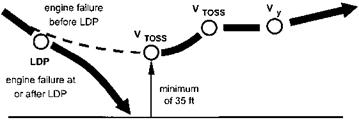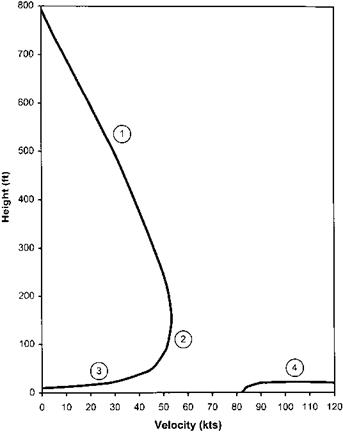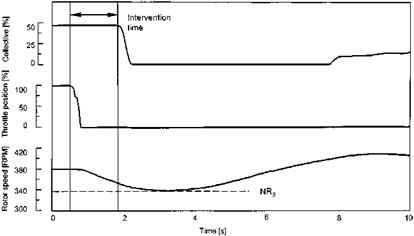AFCS failures
The evaluation of failures within flight control systems is of particular importance because of the potential that these failures have to disturb the flight path of the helicopter. As flight control systems are fitted to provide additional stability and, in the case of autopilots, to control the aircraft they must have sufficient authority to make large enough inputs. Thus the AFCS designer is faced with balancing two conflicting requirements: high performance and benign failure characteristics. Of course one way of achieving both is to design the system with triplex or quadruplex redundancy and voting logic. This approach does suffer disadvantages in terms of complexity and cost that often make it unattractive for limited authority AFCSs. For these simpler systems the more usual solution is to employ simplex or duplex limited authority, fast-acting series actuators and high authority, slow-acting parallel actuators. Consequently the failure testing of these classes of AFCS is primarily concerned with evaluating the effect that failures may have on both series and parallel actuators and hence on the flight path of the aircraft.
There are a number of different types of failure that can occur within an AFCS and it is convenient to divide these into active and passive failures. The active failures are those that cause an uncommanded flight path disturbance while passive failures involve a loss of function but no disturbance. Active failures are clearly the more serious of the two and this category can be further sub-divided into oscillatory failures and runaways. Oscillatory failures are usually caused by problems with the feedback path that results in the actuator constantly reversing direction. Runaways may have many causes such as failures within the computation or erroneous sensor signals. It goes without saying that a series actuator runaway can be particularly hazardous should it occur in an agile aircraft that is flying close to the ground at high speed. Although passive failures are likely to be far less dramatic they can still lead to potentially catastrophic consequences. For example, if a radar altimeter hold drops out when operating at night, low level over the sea there is a considerable danger of the aircraft descending unnoticed and striking the surface.
7.6.6.1 Test technique
The main factors that influence the way the pilot reacts to the failure are the recognition that something has occurred and the level of involvement of the pilot in the flying task. From these two factors the desired intervention time is determined as has been discussed earlier. The test philosophy centres on injecting appropriate failures and incrementally increasing the intervention time until the specification requirements have been met or a limit is reached. The testing starts with practise of recoveries from extreme pitch and roll attitudes; this is approached cautiously as it is often the case that the highest stresses experienced by the airframe occur during the recovery and not during the runaway itself. If a simulator is available this can be useful in working up the crew. Failures are typically injected into the AFCS using a ‘runaway box’ starting at the most benign conditions of low speed, mid-CG and series actuators nulled (for dual lane systems). The testing then moves on to evaluate less benign conditions. In the case of actuator runaways the pilot is usually given an aircraft attitude at which to commence recovery: this is gradually increased until the required intervention time has been achieved or a test limit is reached. During the test plots of the intervention pitch (or roll) attitude versus maximum attitude and maximum load factor are maintained. For pitch runaways it is important to establish the height change that results from the full intervention time at each condition and in particular the height loss for forward runaways. During the test programme the utility of any AFCS cutout is assessed and the optimum strategy for recovery from runaways established. Cutouts may serve a variety of functions: to temporarily disengage part or all of the AFCS as and when a failure is recognized, to enable fault diagnosis and to re-engage serviceable parts of the system following a single failure.
7.6.6.2 Results of testing
Figure 7.18 shows a time history of a pitch runaway. Such traces are a typical way of presenting results. The results obtained during the test programme can have a number
|
Fig. 7.18 Pitch series actuator runaway – test data. |
of implications for the AFCS and for the way that the aircraft is operated. In the worst case it may require changes to the design of the system such as altering the speed or authority of the actuators. Making the system more fault tolerant by fitting a monitor channel which automatically disengages a faulty lane is another possible solution to unsatisfactory failure characteristics. More often the test programme will result in advice to aircrew and limitations on the use of the system. Such advice might stress the importance of timely and accurate nulling of the series actuators prior to NOE flight or operations close to the sea surface. Alternatively a deliberate forward bias of the series actuators may be obtained by trimming forward thereby reducing the severity of a nose-down runaway. Limitations that could be imposed include maximum speeds with the full AFCS and when operating with a degraded system. It might also be necessary to impose a minimum height for NOE flight if the height loss following a nose-down runaway is too great. The need for operational crews to practise recoveries from runaways may also be a recommendation from the testing. This may lead to a production version of the flight test ‘runaway’ box being incorporated into all fleet standard rotorcraft.
[1] undercarriage type – wheeled or skidded;
• available stroke in undercarriage – main and tail/nose;
• crashworthiness of cockpit, fuselage floor or cabin and fuel system;
• tail boom strength;
• field of view;
• rotor inertia.
[2] Conduct a hover (H1) at the altitude (Hp1) giving the highest desired referred weight (W1) and establish the hover power.
(2) Descend and establish H2 at Hp2 ( = Hp1 — 500 ft) and W2.
(3) Set maximum power and conduct MPV1, timing the ROC in the altitude band Hp1 —100 ft to Hp1 + 300 ft. The extra 100 ft allows for a small increase in Hp to compensate for the fuel burned between H1 and MPV1 in order to maintain W1 .
(4) Descend and establish H3 at Hp3 ( = Hp2 — 500 ft) and W3. Conduct MPV2 as above.
(5) Repeat the process until the desired data is acquired.
[3] Pressure altitude;
• Elapsed time;
• Indicated airspeed;
• Fuel state;
[4]yy
[5] Disturbance along the longitudinal axis. Suppose the rotor is subjected to a disturbance equivalent to the rotor developing a forward airspeed component. When the disturbance appears the hovering rotor develops an asymmetry in tangential velocity and subsequent change in AOA and lift: more on the advancing side (A) and less on the retreating side (R).
[6] Disturbance along the vertical axis. If the rotor develops a sink rate the inflow velocity component is reduced and the AOA consequently increased. Since the rotor is in pure vertical flight the increase in lift, arising from the increase in AOA, will be equally distributed around the azimuth.
[7] Change in blade pitch. Suppose the rotor is disturbed such that the swash plate is moved instantly and the rotor attitude is initially unchanged. (This disturbance mode is an important case in considering the manoeuvre stability of a helicopter.) If the swash plate is tilted nose-up (positive direction) an increase in blade pitch
[8] SHSS technique – GSDIfitted aircraft. The helicopter is flown into wind with zero roll angle and slipfall central (GSDI drift needle reading zero) and aircraft heading is noted. The helicopter is then yawed to change heading by the sideslip angle required while maintaining the aircraft track into wind. The GSDI drift needle should indicate the change in sideslip angle and, if the correct flight path has been maintained, this value will give a working approximation of sideslip angle.
[9] SHSS technique – non-GSDIfitted aircraft. The helicopter is flown down a line feature (a runway) into wind and aircraft heading is noted. The helicopter is then yawed to change heading with zero roll angle and slipfall central by the sideslip angle required while maintaining aircraft track down the line feature.
[10] The cyclic is deflected out ofthe turn, that is towards the left (Al positive), therefore Lr. r > Lv. v and the yaw rate contribution is dominant.
• The cyclic is deflected into the turn (Al negative), thus Lr. r < Lv. v and the sideslip contribution is dominant.
[11] Desired performance. This is the highest level of performance and is awarded when the desired tolerance is achieved with a satisfactory pilot workload. No improvement in handling qualities is required therefore (HQR 1-3).
• Adequate performance. In this category either the desired tolerance is achieved but with an unsatisfactory level of pilot workload (HQR 4) or the adequate tolerance is achieved with a tolerable level of workload (HQR 5 & 6). An improvement in handling qualities is warranted.
[12] Light engine weight. To obtain a given power output, the gas turbine engine will normally be much lighter than the corresponding piston engine. This advantage is extremely important since it allows smaller turbine engined helicopters to do
[13] The governor should maintain a sensibly constant RRPM under all power-on conditions. When required the governor should prevent the free turbine from overspeeding. At the same time the governor should be free from NF/NR instability at low collective pitch settings over the whole range of possible helicopter all-up weights.
• The response of the engine and/or free turbine governing system should be quick enough to maintain the RRPM (NR) within limits during large, rapid power changes.
• The governor should be capable of providing stable control at all times notwithstanding that the engine might be ON or OFF load.
• In multi-engine installations, individual engine governors must be so configured that power matching can be achieved easily and consistently throughout the power range.
[14] To align the tailplane with the rotor downwash in low speed flight in order to improve performance, reduce the nose-up hover attitude and to reduce the tendency to pitch-up during transitions to forward flight.
[15] Rotor acceleration. The appropriateness of the acceleration schedule is checked to ensure that it does not lead to the aircraft yawing on icy or wet dispersals.
• System stability. Due to the high system gain a danger of instability exists in addition to the danger of drivetrain resonance already discussed. Collective doublets and frequency sweeps are made to assess these areas.
[16] Radar altimeter height holds. Because these holds are employed close to the surface and often in a degraded visual environment they require particularly careful evaluation. The accuracy requirements for this type of hold are always more stringent than for barometric height holds. To quote from the same UK military helicopter specification mentioned previously the radar height hold required the height to be maintained to the lesser of 10% or 10 feet. As radar height holds are usually employed in overwater operations testing is conducted with a variety of sea states at a variety of airspeeds and angles of bank. The testing takes place at heights that are operationally relevant; this can be as low as 40 feet in the case of anti-submarine helicopters. If a smoothing circuit is incorporated to deal with wave peaks and troughs then its effectiveness in operation is checked by comparing the performance of the hold when using the raw signal. Careful evaluation is made of the radar altimeter failure modes and the indications to the pilot if the altimeter unlocks.
• Vertical speed holds. These are assessed by selecting RoC and RoD and then timing the aircraft through an altitude band. In an autopilot where the mode operates through the collective channel then the danger of the system causing an excessive power demand is investigated and limitations may be imposed. Similarly a minimum airspeed is always imposed on three-axis systems which hold vertical speed through the pitch channel to prevent the hold operating on the wrong side of minimum power speed. The ease with which the system captures the selected

















